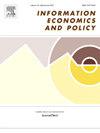数据汇总中的范围经济:来自卫生数据的证据
IF 3.2
3区 经济学
Q1 ECONOMICS
引用次数: 0
摘要
数据聚合中的范围经济(ESDA)是由涉及相同观测值的互补数据集的组合产生的。我们通过逐步和随机地将健康和社会经济变量(预测因子)添加到我们用于预测健康结果的机器学习模型中来估计ESDA。我们发现在保持观测数不变的情况下,变量数对预测质量有积极影响。我们观察到变量互补性与ESDA之间存在正相关关系。ESDA表现出收益先增加后减少的迹象。在我们的数据中,我们进一步观察到高贡献预测因子的长尾。这些发现表明,在数据汇总中,范围回报的性质可能取决于预测者信息内容的分布。这强调了可变特征在确定ESDA是否有可能创建数据进入壁垒方面的重要性。这些结果可以帮助决策者设计数据共享计划,如欧盟的欧洲共同数据空间。本文章由计算机程序翻译,如有差异,请以英文原文为准。
Economies of scope in data aggregation: Evidence from health data
Economies of scope in data aggregation (ESDA) are generated by the combination of complementary datasets involving the same observations. We estimate ESDA by progressively and randomly adding health and socioeconomic variables (predictors) to the machine-learning models we use to predict health outcomes. We find a positive effect of the number of variables on prediction quality, while holding the number of observations constant. We observe a positive relationship between variable complementarity and ESDA. ESDA show signs of increasing returns followed by decreasing returns. We further observe a long tail of highly contributing predictors in our data. These findings indicate that the nature of returns to scope in data aggregation may depend on the distribution of the predictors' information content. This underscores the importance of variable characteristics in determining ESDA's potential to create data barriers to entry. These results can help policymakers in designing data sharing initiatives such as the European Union's Common European Data Spaces.
求助全文
通过发布文献求助,成功后即可免费获取论文全文。
去求助
来源期刊

Information Economics and Policy
ECONOMICS-
CiteScore
5.00
自引率
10.70%
发文量
27
期刊介绍:
IEP is an international journal that aims to publish peer-reviewed policy-oriented research about the production, distribution and use of information, including these subjects: the economics of the telecommunications, mass media, and other information industries, the economics of innovation and intellectual property, the role of information in economic development, and the role of information and information technology in the functioning of markets. The purpose of the journal is to provide an interdisciplinary and international forum for theoretical and empirical research that addresses the needs of other researchers, government, and professionals who are involved in the policy-making process. IEP publishes research papers, short contributions, and surveys.
 求助内容:
求助内容: 应助结果提醒方式:
应助结果提醒方式:


